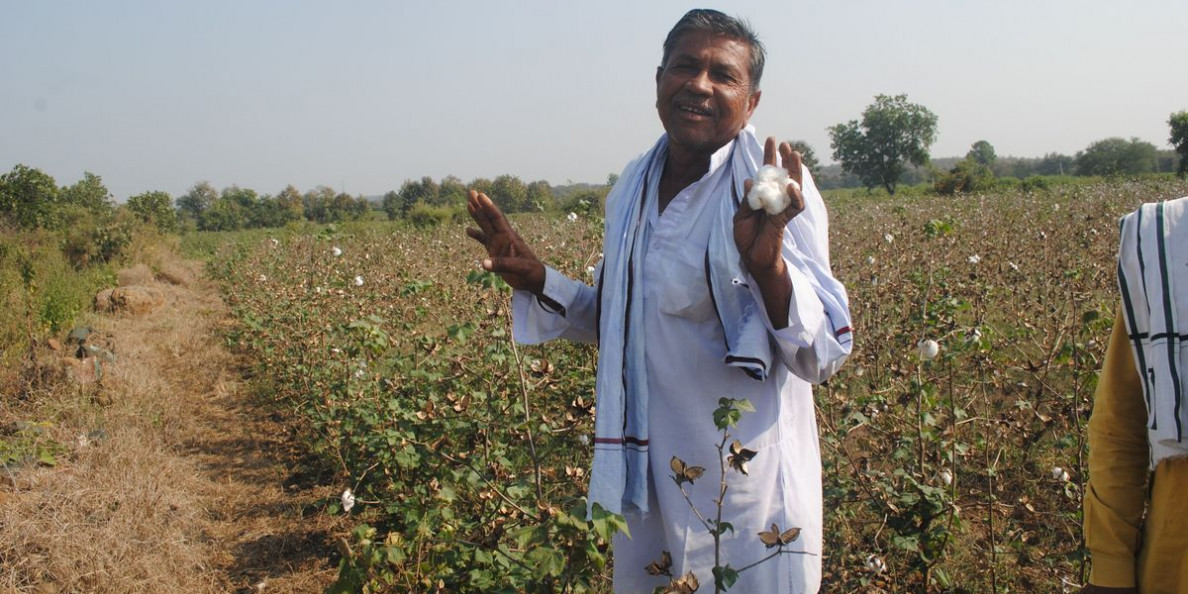At least 40 people have died from pesticide poisoning since August and hundreds have taken ill.
The relentless farmer suicides in Maharashtra’s Vidarbha have an added dimension this year: higher than usual pest attacks on cotton and soyabean leading to indiscriminate spraying of pesticides and, consequently, possible poisoning deaths.
The Central Institute for Cotton Research has detected herbicide-tolerant genes in the genetically modified Bt cotton seeds of five companies, confirming that the illegal hybrid seed is still sown in Maharashtra, as in some other states.
Adding to this litany of miseries are widespread reports of Bt cotton falling prey to the pink bollworm – Bt cotton is supposed to be resistant to this pest – and the fact that loan waivers announced by the state government in June haven’t come through yet.
Sucking pests such as the mealy bug and the pink bollworm have damaged vast tracts of cotton – all 40 lakh hectares across Maharashtra, according to Kishore Tiwari, head of the state government’s special task force to tackle the agrarian crisis – necessitating greater spraying of pesticides, with devastating consequences for people in the region.
Since August this year, pesticide poisoning has killed at least 40 people, mostly labourers across the six districts of Vidarbha, with Yavatmal alone accounting for at least 22 deaths and over 800 people affected. Vidarbha has 16-17 lakh hectares of land under cotton cultivation.

Ankush Rathod’s eyes are still foggy over a month after returning from hospital. The 22-year-old cannot see clearly, his eyes are reddish and have a vacant look. He has to put eye drops daily and visit a private hospital every week. “I could not see anything, my eyes were burning,” he said.
Rathod has not returned to work. A resident of Sakhra village in Ghatanji taluka of Yavatmal district, he has been working as a daily wage labourer for three years, spraying pesticide on cotton. This year too he used a mix of two chemicals with a power spray. “The cotton was almost my height,” he said.
For Rs 250, landless labourers like Rathod spray pesticides for up to eight hours a day with little protective covering. Some use the hard bikers’ helmet as protection or a kerchief to cover their faces.

Gajanan Meshram, also from Sakhra, said he felt dizzy and got a stomach ache after days of spraying and had to be hospitalised. He is still too fatigued to resume work.
Although Yavatmal’s government hospital is not overflowing with pesticide poisoning cases like in the past few months, there is a steady stream of new admissions, some in the ICU. If it wasn’t bad enough being poisoned, the antidote Atropine could cause seizures and some patients have black marks on their wrists and ankles from being restrained in their hospital beds.
“Why can’t the government ban these toxic pesticides?” asked Govinda Uike, a farmer recovering in the hospital. “Now that we are dying, the government is telling us to use protective kits. We had one kit for the entire village.”

Deadly concoction
Most of those poisoned cannot read, but they know the names of pesticides they use – Profex, Polo, Asataf, Hijack, Police, Coragen, Monocil, Lancergold. Some of these contain organophosphates, chemicals that are highly toxic for the human body. Poisoning is caused if these chemicals come in contact with skin or eyes, or their fumes are inhaled.
In Yavatmal, Kalamb taluka is the worst affected by pesticide poisoning, with four deaths and over 65 people hospitalised. The first death occurred on August 19. Devidas Madavi, 52, had been admitted in hospital 12 days earlier after he complained of loose motions. His wife Mangala said he had been spraying Profex for 15 days before he took ill. He was paid Rs 200 per day. Mangala is now her family primary breadwinner, picking cotton all day for about Rs 120.
In nearby Sawargaon, Gajanan Phulmali grew cotton on his three-acre farm. He was building a new house next to his old shanty but did not see it completed. He took ill after spraying pesticide to check the pink bollworm infestation and the money he had borrowed for the new house went to his treatment. He died on October 1, after 12 days in hospital.

In Amdi village, Ghatanji taluka, at least five people were poisoned, leaving the villagers scared of even picking cotton. One villager Vasant Rathod said he only harvested 20 quintals cotton on his 20-acre farm this season, a fraction of the the yield in previous years. He is banking on the loan waiver to tide over the losses, but the local bank has already turned him away twice because the government has not yet released the money.
About 50 km from Yavatmal in Ner taluka, the bollworm has ruined nearly 1,000 hectares of cotton crop in Mangladevi and surrounding villages. Manoj Umratkar, a farmer in the village, said every single cotton boll in his 20-acre farm was infected. Rambhau Dahapote said he may harvest barely than 4-5 quintal cotton from his eight acres this year as against 110-120 quintals in previous years. This year, farmers here used Police pesticide, which is recommended to be sprayed on sugarcane, that too from tractors and not by hand as it was done here.
In this area, farmers had to bear not just a pest infestation, but also a storm in late October that damaged their crops, including soyabean and pigeon pea. Adding to the farmers’ despair is that few of them have crop insurance.
Atul Rane, a farmer in Sawargaon who has lost his entire cotton crop to pests, rued that the plight of farmers in the region was beyond miserable. “Please go,” he implored, “and tell Chief Minister [Devendra] Fadnavis that we are dying.”

Πηγή: scroll.in


